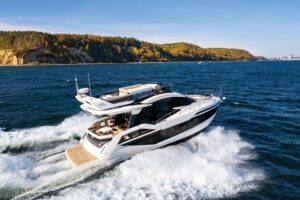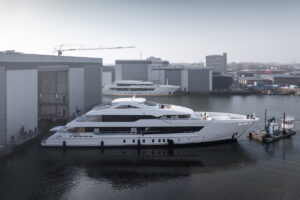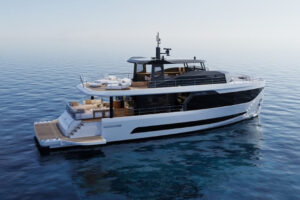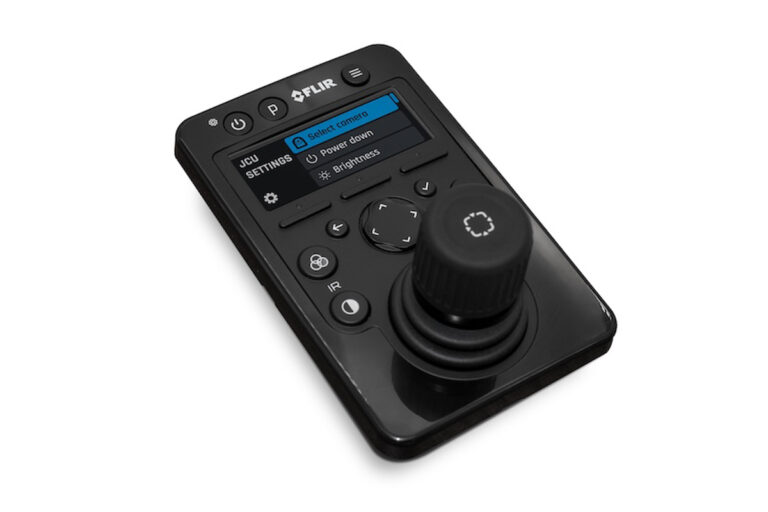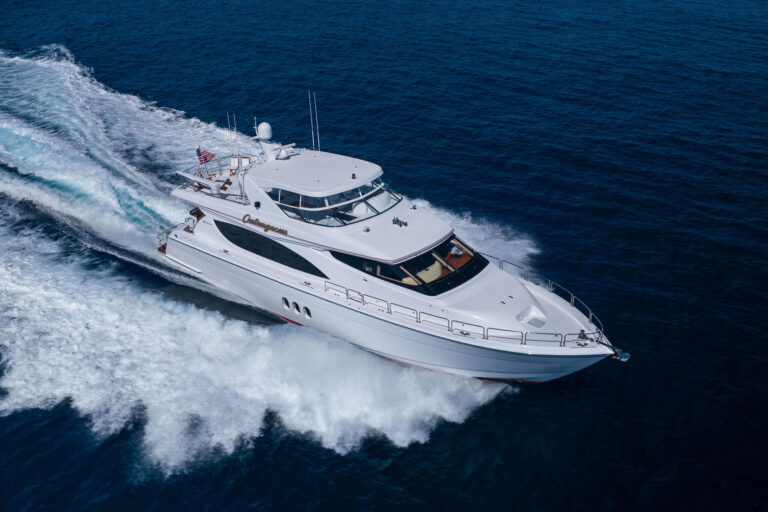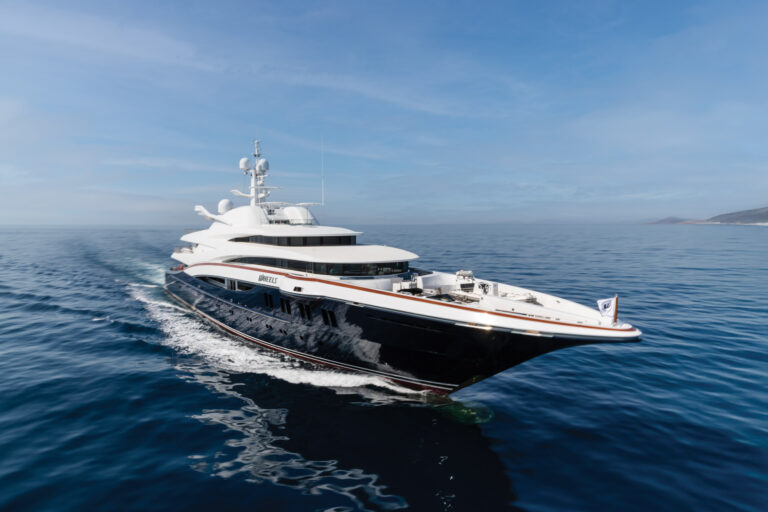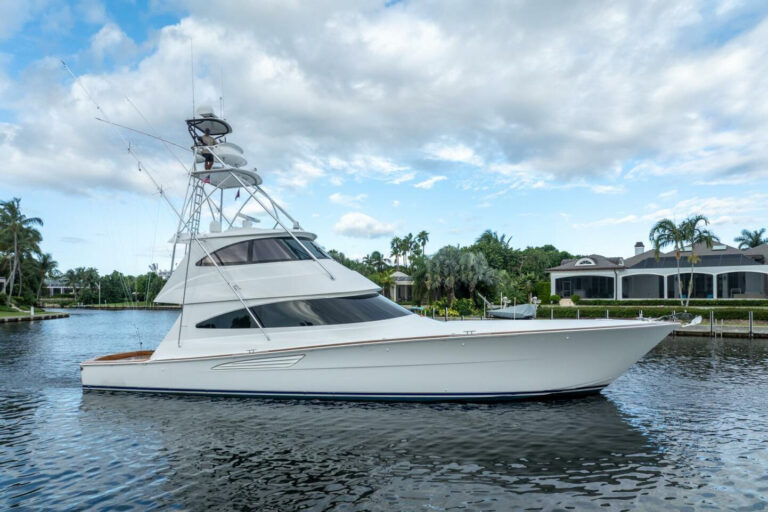Stunning. From keel to bridge, transom to anchor chocks, the word stunning sums up the Sea Force IX 81.5 sportfisherman. That adjective encompasses her sleek dark hull, contrasting stark white superstructure, immaculate engineroom and finely detailed interior design and joinery. If hull number one is any indication of what’s to come, the Force could be the one competing anglers fear most.
“This boat is for a different marketplace-the next generation of boat buyer”, says Sea Force IX’s CEO Ron Rookstool, better known as Rook.
The builder expects to produce four models from 76 to 91 feet, using vacuum-bagged fully cored construction. The quest for perfection guides the company’s philosophy, and all members of the Sea Force IX team have extensive backgrounds in the construction of sportfishing boats. From the design table to completion, hull number one was within 40 pounds of the engineer’s estimate.
They have learned to pay special attention to the environment of the laminating shed during the lay-up of the hull, closely monitoring humidity and temperature and changing formulas accordingly.
“We are fastidious about quality control. Our process is a chemistry set we can control. We use monolithic construction, everything is bonded together as a unit”, says Rick Hyer, the engineer whose team designed the 81.5.
Sea Force’s stringer system stiffens the bottom, which contributes to her quiet running and enhances handling; those attributes were clear even in the calm seas during my sea trial. To achieve a monolithic structure, Sea Force tapes and bonds the cabin sole to the hull, cleats and glasses the cabinetry and bonds the remaining interior structure, including four bulkheads, to the hull. Decks are cored with high-density foam-for stiffness and light weight-fully fared and finished in Awlgrip.
In short, Sea Force IX has created a yacht that nimbly navigates tight marinas (Rook parked her without using the hydraulic thruster), busts it out to the fishing grounds when others are apprehensive and when the drag sings out, is up to a quick spin and an aggressive backward push to get line back on the reel. I aggressively backed her down; the entire after section of the hull rose slightly instead of digging in and the cockpit remained dry.
The big yacht accelerated from stop to top in 24 seconds, without the aid of her trim tabs. Although you can trim her by transferring fuel loads manually from any tank to any tank and ultimately to a day tank system outfitted with an Alpha-Laval fuel polisher, she didn’t need it during my time aboard. Her stance was darn near level at 24 knots. Tank-testing at the Stevens Institute in Hoboken, New Jersey, clearly was worth the effort.
Lock to lock the steering wheel completed four revolutions. High-aspect ratio rudders let her carve turns more like a 60-footer.
“The moderate keel is the secret to her maneuverability”, Hyer said, “and everything on the bottom is recessed; the shaft is sleeved. The three feathers on the bottom, the chine and two strakes, deflect water sideways and geometry lifts the bottom. The current hull draws 5 feet, 11 inches, but tunnels will be available in the future and should shave six inches off the draft.”
Power comes from a pair of 2,000 hp 16V2000 MTUs, which deliver a range of 2,600 nautical miles at 10 knots and 850 at 28 knots. At 1950 rpm we were zipping along at 27 knots, and the decibel level in the bridge was 69. This level of hush is the result of Sea Force’s working closely with Soundown for sound attenuation and DeAngelo for the exhaust. The MTUs are isolation mounted for sound and vibration dampening. Stout engine beds of inch-thick steel on foam stringers capped with aluminum are stiff enough to let the isolation do the job without flexing the hull. Precise shaft alignment, achieved by laser, and then re-shot with a quantum refractor laser to exacting standards, further enhances the yacht’s smooth running.
Meticulously planned, the engineroom and machinery spaces are finished as handsomely as those aboard some of today’s megayachts. The builder worked closely with industry specialists, such as Trident, Delta-T and Aeoquip for hoses, dry engineroom airflow and fuel lines, respectively.
Outboard of the engines are unique stowage shelves rimmed with polished stainless rails, a perfect area for bulk oil, spare filters and other service items. A four-drawer tool chest has a dedicated shelf affixed to the forward bulkhead.
The refrigeration compressors are raised to eye level and isolated behind sealed plexiglas doors, further keeping decibel levels acceptable. Not only is the finish Class 1, but the builder uses diamond plate brushed aluminum and polished stainless steel to dress up exposed surfaces. DDEC control panels are easily reachable from the cockpit access to the engineroom.
Rounding out this technically rich environ are the 11 tons of chilled-water air conditioning, an Eskimo ice maker and safety sea cocks and pumps for emergency water removal. The custom electrical distribution boxes are zoned-Rook is justifiably concerned about fire and believes long wire runs carry fire. The electrical system uses switches, not solenoids, for additional safety, and the main distribution panel is in the after bulkhead of the saloon.
As tempted as I was to further poke around the innards, I ventured up to the enclosed flying bridge and found it equally captivating. Flanking the single pedestal helm chair are twin riding seats, each with room for two. The windshield has five-panels of 3/8-inch curved tempered glass. I would have preferred fewer, larger panels, but the builder feels this design is stronger, and that is how Sea Force IX does things. Seated at the helm chair the captain can view the Mappa burl console, chosen to complement the teak joinery, and then all the way forward to the foredeck. This layout not only created a pilothouse-type environment that was a pleasure from which to command, but one that can multi-task at the dock with a flat-screen TV, sink and settee with table. An open bridge is optional.
Headroom throughout the yacht nudges 7 feet, and the saloon benefits from the reach in a feeling of spaciousness. The combined feel of the island galley-with Corian counters, fixed bar stools and custom refrigeration-and the social area is one of exquisite quality, far from what one would expect on a fishing machine. A wet bar is in one corner off the after bulkhead, but Sea Force offers a day head for that nook, an option I would exercise.
The builder’s fit and finish are exemplary as evidenced by the furniture-like sheen created by the use of premium Italian coatings. Each contact point where joinery panels meet has a kiss joint that eliminates veneer-to-veneer contact. This compensates for any flexing and allows easy replacement if needed. The headliner had soft flowing curves, and the sole was finished with carpet and Amtico.
The extended companionway leading to the accommodations is lined with stowage. Heads are large, and guests will use the day head that serves the second guest stateroom. Guests fortunate to stay aboard will be treated to warmly decorated and comfortable staterooms.
The full-beam master is artificially lit and an owner will find suitable stowage, a vanity counter and en suite head. The builder has created an easy-lift mattress for access to the additional stowage area below.
Crew quarters are situated between the master and engineroom and have private areas for the captain and mate. An extra freezer and washer/dryer are tucked into the bulkhead and the crew’s wet head has watertight doors that lead to the engineroom.
Lest we forget, the Sea Force 81.5 is a sportfisherman at heart. Her cockpit will hold a half-court basketball game. In-sole fish boxes are Jacuzzi-size and the lazarette is reached via Freeman aluminum hatches. All expected fishing amenities are in place, and Sea Force has created a wire well in the transom corners for the mate to get as close as possible for safer handling of fish.
One cockpit compartment hides the icemaker and the builder has left room for owner customization of the remaining lockers. Sea Force has raised the bar with seamless teak covering boards, custom hawse pipes, flush deck hardware and wide side channels for quick drainage.
Each owner will not merely purchase a yacht, but become part of the family. Sea Force provides a laptop with every yacht, loaded with the full schematics of the ship, and an iron clad warrant. Rook fully expects to inspect every boat quarterly, whether the owner requests it or not.
It’s just Rook’s and Sea Force IX’s way of doing business.
Contact: Sea Force IX; (941) 721-9009; www.seaforceIX.com. For more information, contact: (866) 922-4877

